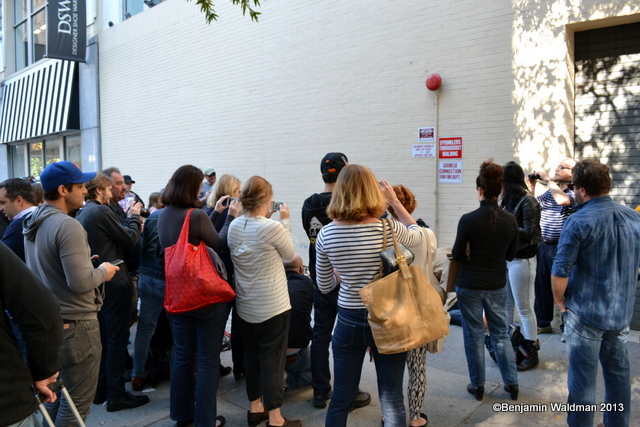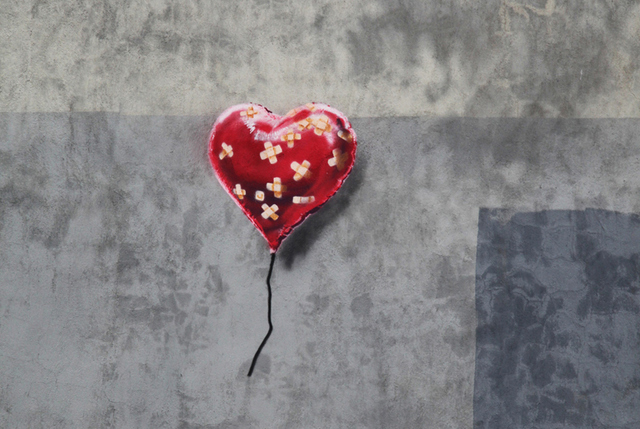It has been a little over 12 months since Banksy’s NYC residency came to an end last Halloween with his final act of vandalism: his name in big, shiny, silver bubble letters (quite literally) hanging from a wall in Queens, two months before the infamous white-washing of 5Pointz. The bubble letters were taken by the NYPD, who took them from two amateur thieves (who could have taken a lesson or two from Thomas Crown). Shouts from a crowd of onlookers were first aimed at the thieves and later, to the police; some of them (including Brooklyn Street Art’s Jamie Rojo) were arrested. The entire maddening scene was recorded on video and put on YouTube, Instagram, Vine etc. It was an outlandish ending to one of the most bizarre and polarizing art events to ever happen in NYC.
What Banksy personally accomplished with his Better Out Than In project is unknown to us (or anyone who isn’t Banksy. But the artist, whose message is as illusory as his identity, may not have anticipated the fury of the social media firestorm, so much so that someone would want to document the madness and have it shown on HBO.
Banksy Does New York (premiering on Monday, showing on HBOGo now) is a documentary whose purpose is to show the hysteria that seemed to fill the streets of NYC during Banksy’s last visit to the “Big Apple.” The content of this documentary is promoted as coming from the people of New York themselves. Director Chris Moukarbel (in a fashion similar to what film director Kevin B. Lee did with last year’s Transformers: Premake) compiled video footage from various Internet channels (YouTube, Instagram, Vine, Twitter, etc.) uploaded by select Banksy “hunters” to showcase the scene found at all 31 days of Banksy’s NYC residency. It does not commit fully to its tagline of being a “user generated film”, but, even with some stumbles, it manages to provide at least some insight into the madness that was Better Out Than In.

For those of you who are unaware/spared of what happened last October, here is the upshot: Last October, Banksy—mysterious, controversial and polarizing British street artist—announced that for each day in October, he would be revealing a new piece, somewhere in NYC. For all 31 days (minus one due to police activity) Banksy placed art throughout the five boroughs. The art came in the form of stencils (his usual tactic of vandalism), sculpture, a column in the New York Times, as well as video and performance art (we have a rundown of all the work listed here).
The way New Yorkers found out about each Banksy piece was first by the artist himself. On his Instagram page @BanksyNY and his website; he would upload a photo of his latest creation. The photo would then be re-posted on practically every NYC blog (us included) and people would engage in a sort of scavenger hunt, trying to be the first person to find it. When the work was found, some, like the people whose work is featured in this film, came to take a photo; others, like “graffiti artist” Omar for example, went to deface it.

The documentary reminds us of the lengths some of us went through to be a part of this weird art event. While the film false advertises its content by providing professional footage and talking head conversations, it does feature a lot of user-generated content, all of it showcasing the insanity of New Yorker’s over the most popular thing happening at the time. For most of the film’s runtime, a pair of dog walkers who went under the Internet handle of @twowaytraffic provide a running commentary on the search for Banksy’s art. Some people may find the duo amusing and charming, others might find them helplessly annoying. Perhaps this was a choice made by the director, to present a duo that would split the audience; much like Banksy himself. Then again, like Banksy’s artwork himself, we probably should not look into this too seriously.
The interviews do give us a break from the shaky cam madness and, it turns out, provide quite a bit of commentary, insight and analysis into Banksy’s residency work. Included are reporters from The Village Voice, Huffington Post and The New York Observer talking about Banksy’s impact, interspersed with commentary from those more involved in the street art scene like Luna Park, RJ Rushmore, and the duo behind Brooklyn Street Art.
When the audience is not watching the journey of the dog walkers and the interviews, the film does get into a few subplots. The most interesting look is what happens to a particular piece once it was stolen, involving an art dealer and a family from Queen who comes into possession of the 22nd Banksy piece, Everything but The Kitchen Sphinx. The piece was discovered in Willets Point, Queens and was quickly loaded onto a truck. The family who owns the truck meet with a pretentious art dealer, (with credit to the film, the director has fun with), and the ensuing story becomes a critique of the “fine art” world. The interactions between these people from different worlds and the hopes of this particular family, is both interesting and heartbreaking.
The subplot that felt most underdeveloped, or perhaps deserving of its own documentary was the focus on 5Pointz. It is not because it is not interesting, or that the story and history of 5Pointz does not have a broader meaning to the current state of NYC, it is because it is interesting and its destruction does have a broader meaning to the current state of NYC. One year later, more relevant is the on-going struggle at 5Pointz, and how its recent demolition does not prevent the developer from seeking to trademark the name 5Pointz for his future residential skyscrapers.
The documentary really did not tell us too beyond what we already knew: the press coverage, Mayor Bloomberg’s response, the defacing of the artwork, the theft, all of it. Perhaps it is that not enough time has gone by for this documentary to feel fresh, but it’s still a fun watch and revisit for New Yorkers.
For a history lesson into the Better Out Than In Banksy residency, check out our review of Ray Mock’s book Banksy In New York or see all 31 days of Banksy’s installations here.
If you want to go see some non-Banksy street art, contact the author @ChrisLInoa






